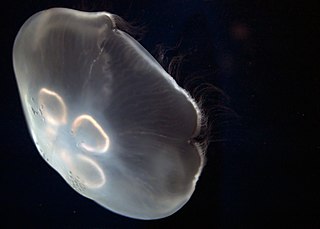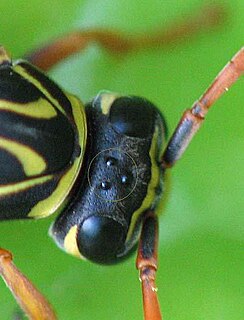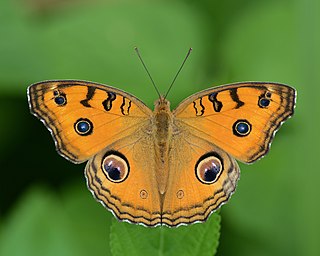Related Research Articles

A pigment is a colored material that is completely or nearly insoluble in water. In contrast, dyes are typically soluble, at least at some stage in their use. Generally dyes are often organic compounds whereas pigments are often inorganic compounds. Pigments of prehistoric and historic value include ochre, charcoal, and lapis lazuli.

Ochre, or ocher in American English, is a natural clay earth pigment, a mixture of ferric oxide and varying amounts of clay and sand. It ranges in colour from yellow to deep orange or brown. It is also the name of the colours produced by this pigment, especially a light brownish-yellow. A variant of ochre containing a large amount of hematite, or dehydrated iron oxide, has a reddish tint known as "red ochre".

Rhopalia are small sensory structures of certain Scyphozoan and Cubozoan species.

The California two-spot octopus, often simply called a "bimac", is an octopus species native to many parts of the Pacific Ocean including the coast of California. One can identify the species by the circular blue eyespots on each side of its head. Bimacs usually live to be about two years old. They are closely related to Verrill's two-spot octopus. In 2015, the genome was sequenced.

A simple eye refers to a form of eye or an optical arrangement composed of a single lens and without an elaborate retina such as occurs in most vertebrates. In this sense "simple eye" is distinct from a multi-lensed "compound eye", and is not necessarily at all simple in the usual sense of the word.

Ocellus Lucanus was allegedly a Pythagorean philosopher, born in Lucania in the 6th century BC. Aristoxenus cites him along with another Lucanian by the name of Ocillo, in a work preserved by Iamblichus that lists 218 supposed Pythagoreans, which nonetheless contained some inventions, wrong attributions to non-Pythagoreans, and some names derived from earlier pseudopythagoric traditions.
The Timpe and Runyon classification of nontuberculous mycobacteria based on the rate of growth, production of yellow pigment and whether this pigment was produced in the dark or only after exposure to light.
An equivalence group is a set of unspecified cells that have the same developmental potential or ability to adopt various fates. Our current understanding suggests that equivalence groups are limited to cells of the same ancestry, also known as sibling cells. Often, cells of an equivalence group adopt different fates from one another.

Junonia almana, the peacock pansy, is a species of nymphalid butterfly found in Cambodia and South Asia. It exists in two distinct adult forms, which differ chiefly in the patterns on the underside of the wings; the dry-season form has few markings, while the wet-season form has additional eyespots and lines.It is listed as Least Concern in the IUCN Red List.
Photoreceptor can refer to:

Lasiommata maera, the large wall brown, is a butterfly in the family Nymphalidae.

The Piedmont ringlet is a member of the family Nymphalidae. It is an Alpine butterfly.

Hipparchia hermione, the rock grayling, is a butterfly of the family Nymphalidae. The species can be found in Central Europe, Southern Europe, Eastern Europe, North Africa, Anatolia and the Caucasus.
The Triton epaulette shark is a species of bamboo shark in the genus Hemiscyllium, that is composed of nine morphologically similar, yet distinct sharks that are geographically restricted to New Guinea and northern Australia. Hemiscylliidae are small nocturnal sharks aptly named "walking sharks" who exhibit a "crawling" movement while foraging on the ocean floor for fish and benthic invertebrates.

Epinotia signatana is a moth of the family Tortricidae. It is found from England and Scandinavia to the Mediterranean Sea, to eastern Russia, China, Korea, Burma and Japan.

Grapholita jungiella is a moth of the family Tortricidae. It is found in most of Europe, east to the Near East and the eastern part of the Palearctic realm.
An ocellus is a simple eye found in invertebrates, in which pigment is distributed randomly and for which there are no additional structures. It is not to be confused with the ocelloid, a light-sensitive structure found in some dinoflagellates.

Eucosma aspidiscana, the golden-rod bell, is a species of moth of the family Tortricidae. It is found in China, Mongolia, Korea, Japan, Russia, North Africa and most of Europe. The habitat consists of woodlands, downland, waste grounds and cliffs.

Albinism is the congenital absence of any pigmentation or colouration in an animal, plant, or person, resulting in white hair, feathers, scales and skin and pink eyes in mammals, birds, reptiles, amphibians and fish and invertebrates as well. Individuals with the condition are referred to as albino.

Tasbacka is an extinct genus of sea turtle containing several species.
References
- ↑ "Eye (invertebrate)" McGraw-Hill Encyclopedia of Science & Technology, vol. 6, p.790 2007